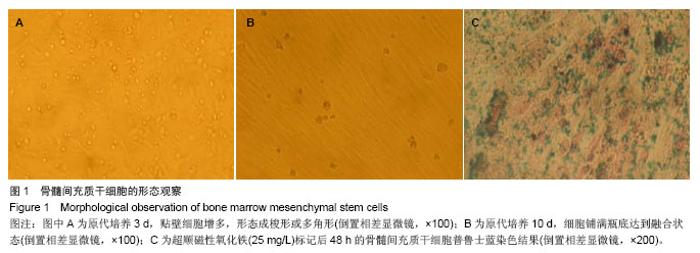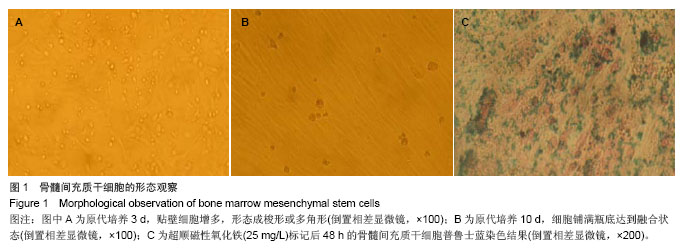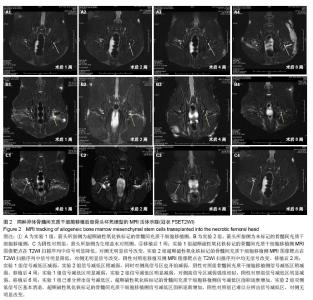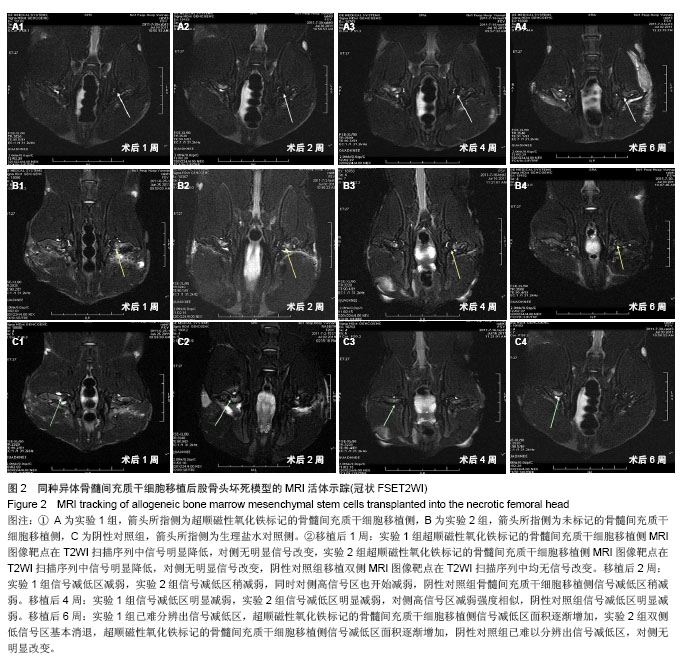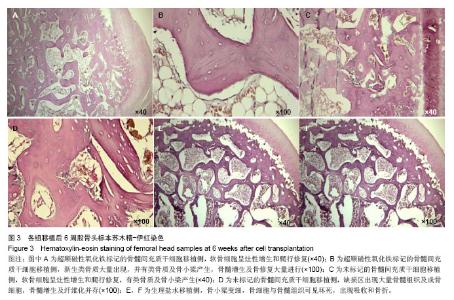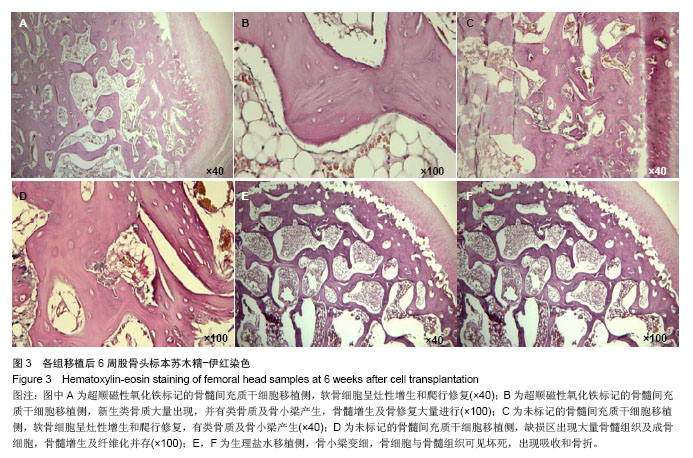| [1]Hernigou P, Beaujean F, Lambotte JC.Decrease in the mesenchymal stem-cell pool in the proximal femur in corticosteroid-induced osteonecrosis.J Bone Joint Surg Br. 1999;81(2):349-355.
[2]孙伟,李子荣,史振才,等.骨髓间充质干细胞对股骨头坏死缺损模型修复的组织学观察[J].中国康复理论与实践,2005,11(1):4-6.
[3]Willenbrock S, Knippenberg S, Meier M,et al.In vivo MRI of intraspinally injected SPIO-labelled human CD34+ cells in a transgenic mouse model of ALS.In Vivo. 2012;26(1):31-38.
[4]de Chickera S, Willert C, Mallet C,et al. Cellular MRI as a suitable, sensitive non-invasive modality for correlating in vivo migratory efficiencies of different dendritic cell populations with subsequent immunological outcomes.Int Immunol. 2012; 24(1):29-41.
[5]孟增东,邱伟,胡彪,等.超顺磁性氧化铁纳米颗粒体外标记兔骨髓间充质干细胞的安全性以及MRI成像特征[J].中国组织工程研究, 2012,16(6):951-957.
[6]Urdzíková L, Jendelová P, Glogarová K,et al. Transplantation of bone marrow stem cells as well as mobilization by granulocyte-colony stimulating factor promotes recovery after spinal cord injury in rats.J Neurotrauma. 2006;23(9):1379- 1391.
[7]Novotna B, Jendelova P, Kapcalova M,et al.Oxidative damage to biological macromolecules in human bone marrow mesenchymal stromal cells labeled with various types of iron oxide nanoparticles.Toxicol Lett. 2012;210(1):53-63.
[8]Baklanov DV, Demuinck ED, Thompson CA,et al.Novel double contrast MRI technique for intramyocardial detection of percutaneously transplanted autologous cells.Magn Reson Med. 2004;52(6):1438-1442.
[9]Muldoon LL, Sàndor M, Pinkston KE,et al.Imaging, distribution, and toxicity of superparamagnetic iron oxide magnetic resonance nanoparticles in the rat brain and intracerebral tumor.Neurosurgery. 2005;57(4):785-796.
[10]Arbab AS, Bashaw LA, Miller BR,et al.Intracytoplasmic tagging of cells with ferumoxides and transfection agent for cellular magnetic resonance imaging after cell transplantation: methods and techniques.Transplantation. 2003;76(7):1123- 1130.
[11]Struys T, Ketkar-Atre A, Gervois P,et al.Magnetic resonance imaging of human dental pulp stem cells in vitro and in vivo. Cell Transplant. 2013;22(10):1813-1829.
[12]Saldanha KJ, Piper SL, Ainslie KM,et al.Magnetic resonance imaging of iron oxide labelled stem cells: applications to tissue engineering based regeneration of the intervertebral disc.Eur Cell Mater. 2008;16:17-25.
[13]郭晓鹤,步星耀,姜金豆,等.自体骨髓干细胞动员联合辛伐他汀治疗脑出血的实验研究[J/CD].中华临床医师杂志:电子版,2011, 5(24): 7248-7255.
[14]Gronthos S, Zannettino AC, Hay SJ,et al.Molecular and cellular characterisation of highly purified stromal stem cells derived from human bone marrow.J Cell Sci. 2003;116(Pt 9): 1827-1835.
[15]马志兵,袁峰,金培生,等.不同培养方法对兔骨髓间充质干细胞诱导分化为成骨细胞的影响[J].中华实验外科杂志,2013,30(1): 177-178.
[16]常献,陈斌,李长青.转化生长因子-β在骨髓间充质干细胞向软骨细胞定向分化过程中的作用[J].中国矫形外科杂志,2013, 21(15): 1538-1540.
[17]缪黄泰,吴星欣,辛毅,等.碱性成纤维细胞生长因子体外诱导犬骨髓间充质干细胞向心肌样细胞分化[J].新乡医学院学报,2013, 30(10):777-782.
[18]徐丽丽,匡弢,张佳,等.体外诱导骨髓间充质干细胞向神经元样细胞分化:两种方法的比较[J].中国组织工程研究,2013,17(45): 7821-7826.
[19]陈增生,褚强,刘艳凤,等.诱导剂共培养:谁更适宜骨髓间充质干细胞向神经细胞的分化[J].中国组织工程研究,2013,17(32): 5757-5764.
[20]陈亮,何少茹,庄建,等.骨髓间充质干细胞向软骨细胞的分化[J].中国组织工程研究,2013,17(27):4951-4957.
[21]Chen J, Liu R, Yang Y,et al.The simulated microgravity enhances the differentiation of mesenchymal stem cells into neurons.Neurosci Lett. 2011;505(2):171-175.
[22]Bartonícek J, Fric V, Skála-Rosenbaum J,et al. Avascular necrosis of the femoral head in pertrochanteric fractures: a report of 8 cases and a review of the literature.J Orthop Trauma. 2007;21(4):229-236.
[23]Mont MA, Einhorn TA, Sponseller PD,et al.The trapdoor procedure using autogenous cortical and cancellous bone grafts for osteonecrosis of the femoral head.J Bone Joint Surg Br. 1998;80(1):56-62.
[24]Manggold J, Sergi C, Becker K,et al.A new animal model of femoral head necrosis induced by intraosseous injection of ethanol.Lab Anim. 2002;36(2):173-180.
[25]周强,李起鸿,杨柳,等.糖皮质激素诱导性股'目'头坏死模,的血管改变[J].中华外科杂志,2000, 38(3): 212-215.
[26]彭吾训,龚跃昆,李世和,等.液搣冷冻建立犬股骨头缺损坏死模型的实验研究[J].中国康复医学,2005, 20(5): 76-79.
[27]王江泳,王保芝,根慧先,等.改良液氣冷冻法制备家兔股骨头坏死模M的形态学研究[J].河北医科大学学报,2008, 29(1): 5-8.
[28]龚跃昆,彭吾训,李世和,等.股骨头缺血坏死动物模型的建立[J].昆明医学院学报,2004, 25(2): 106-109.
[29]Mont MA, Hungerford DS.Non-traumatic avascular necrosis of the femoral head.J Bone Joint Surg Am. 1995;77(3):459- 474.
[30]Hoffmann NE, Bischof JC.The cryobiology of cryosurgical injury.Urology. 2002;60(2 Suppl 1):40-49. |
